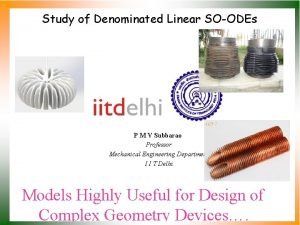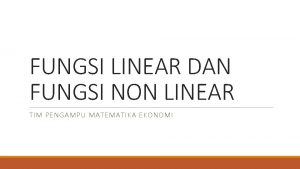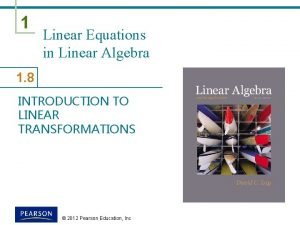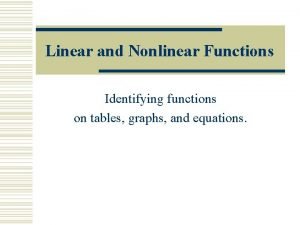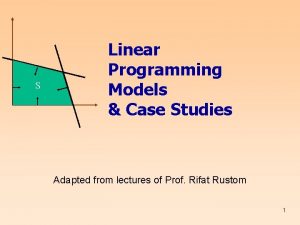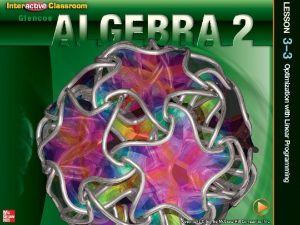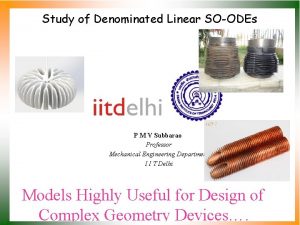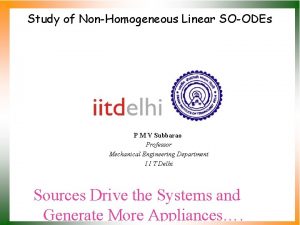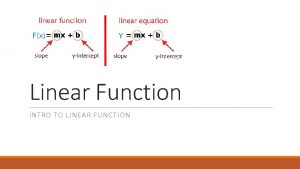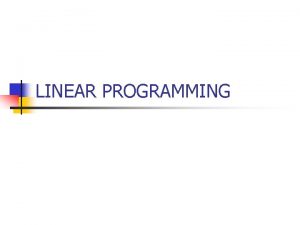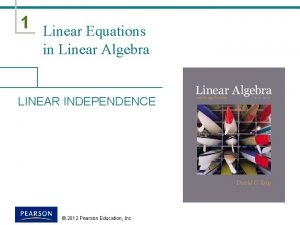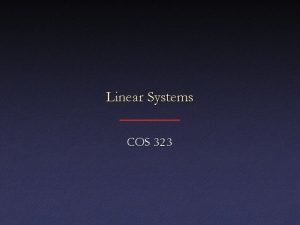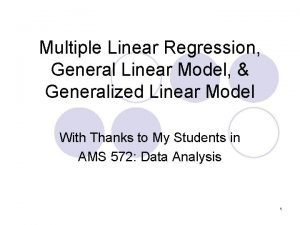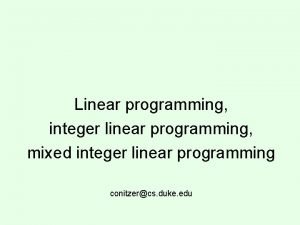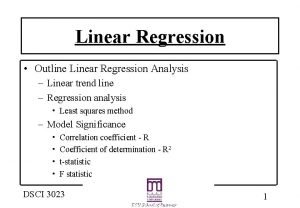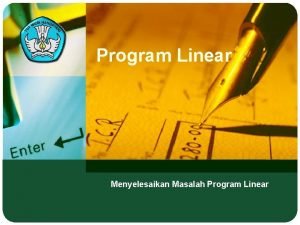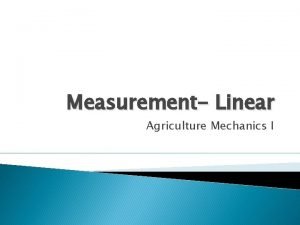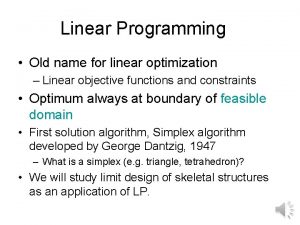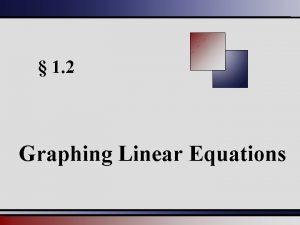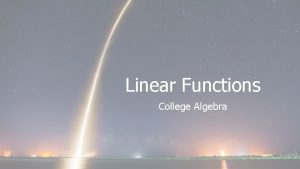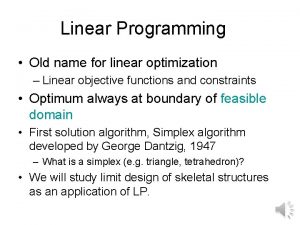Study of Denominated Linear SOODEs P M V































- Slides: 31

Study of Denominated Linear SO-ODEs P M V Subbarao Professor Mechanical Engineering Department I I T Delhi Models Highly Useful for Design of Complex Geometry Devices….

Why Denominated Linear SO-ODEs • Second order linear equations with variable coefficients are in general more difficult to solve than equations with constant coefficients. • Great mathematicians invented solutions for SO-ODEs with specific functions as variable coefficients. • These are: • The Euler Equidimensional Equation (Cauchy –Euler equation). • Family of Sturm-Liouville Differential Equations.

Leonhard Euler • Leonhard Euler (1707 -1783) was arguably the greatest mathematician of the eighteenth century. • One of the most prolific of all time; his publication list of 886 papers and books fill about 90 volumes. • Remarkably, much of this output dates from the last two decades of his life, when he was totally blind. Euler's prolific output caused a tremendous problem of backlog. The St. Petersburg Academy continued publishing his work posthumously for more than 30 years.

Euler s Deeper Influence on the Teaching of Mathematics • Leonhard Euler was not a teacher. • He had a deeper influence on the teaching of mathematics than any other mathematican or mathematics teacher. • His skills of teaching mathematics is seen in his three special treatises. • Introductio in Analysin Infinitorum, 1748. • Institutiones Calculi Differentialis, 1755. • Institutiones Calculi Integralis (1768 -1794). • All the elementary and advanced calculus textbooks published since 1748, are copies of …… Euler.

Euler Equidimensional Equation • Euler’s inventions were so extensive that many 20 th Century mathematicians tried to avoid confusion by naming these inventions after the person who first studied them after Euler. • This equation is also called Cauchy Equidimensional Equation, Cauchy-Euler Equation. • The Euler Equidimensional Equation is a special equation. • The ideas, used to solve second order linear equations with constant coefficients were developed by analyizing Eulers solution to EEE.

Euler Equidimensional Equation • The Euler Equidimensional Equation for the unknown y with singular point at x 0 is given by the equation where k 1 and k 0 are non-dimensional constants.

The concept of Equidimensional Nature • The equation is called equidimensional because if the variable x has any physical dimensions, then the terms with • For any nonnegative integer n, all terms are actually dimensionless. • Euler introduced a genious Approach. • The exponential functions y(x) = e x are not valid Ansaz to the EEE. • It is simple to show that there is no constant such that the exponential is solution.

Original Method of Solution • Consider the Euler Equidimensional Equation where k 1, k 0 and x 0 are real constants. Euler thought an inverse of Method of Characteristics. Invented a quadratic equation for which roots are influenced by k 1 & k 0.

General Solution to Euler Equation • If + -, real or complex, then the general solution of Euler Equation is given by • If + = -= 0, , then the general solution of Euler Equation is given by

Second Generation Solution to EEE • Simplified form of EEE is developed by equating x 0 = 0. • The general case x 0 0 follows this case. or, in standard form • Its hard to think of some likely candidates for particular solutions of above Equation. • A simple power law function is a natural ansatz for above ODE. • An educated guess for the solution is y = x , where is a constant to be determined.

Euler Characteristic Polynomial • For the time being, let us consider only the case of x > 0. • Start with the trial solution y = x This polynomial is sometimes called the Euler Characteristic Polynomial.

Roots of Euler Characteristic Polynomial • If + -, real or complex, then the general solution of Euler Equation is given by • If + = - = 0 , then the general solution of Euler Equation is given by

Solution to Euler Equation with Complex Roots • If + -, complex, then the general solution of Euler Equation is given by

Eulers Analysis of Solution with Complex Roots

The General Solution of EEE Euler formula for complex exponentials

Real Solution to EEE with Complex Roots • “Filter out” all functions containing coefficients with an imaginary part. • Collect the real parts that satisfy the given differential equation, keeping only those whose coefficients are real numbers. • A pair of real valued, linearly independent solutions can be generated using linear combinations Their Wronskian is NEVER ZERO It is easy to verify that both u and v satisfy the EEE.

Reals Solution to EEE • If + -, real , then the general solution of Euler Equation is given by • If + = - = 0 , then the general solution of Euler Equation is given by • If + -, complex, then the general solution of Euler Equation is given by

Solution to EEE by “Change of Variables Method” • The Euler equation can also be solved by a Change of Variables Method. • This approach seeks to convert an Euler equation into one with constant coefficients. • Define

Transformed EEE

In a thermodynamic Persepctive Every ODE is A Model for Specific thermofluid system…. . What drives a system to perform? ?

The Law of Source & System in Thermofluids The flow of energy from a source to a sink through an intermediate system orders that system. Morowitz [1992]

Anatomy of Nonhomogeneous linear SO-ODE • Consider a general linear second order nonhomogeneous ODE. Linear Operator, L(y) Source Function Let us consider most popular and simple thermofluid Model

Solutions of Nonhomogeneous SO-ODE with CC • All solutions of a CC homogeneous equation can be obtained from only two solutions that are linearly independent, called fundamental solutions. • Every other solution is a linear combination of these two. • This result is not longer true for nonhomogeneous equations. • Addition of a fixed function translates the solutions of the homogeneous equation as the solutions of the nonhomogeneous equation. • The fixed function is an additional solution and it is called a particular solution of the nonhomogeneous equation.

Nonhomogeneous Equations Linear Second Order ODE Theorem: Every solution y of the nonhomogeneous CC-SO-ODE where 1 and 0 are constants . is given by yp is the particular solution. One of the method to find such particular solution is known as the undetermined coefficients method.

Methods to Compute Particular Solution • There are mainly two different ways to compute the particular solution of a nonhomogeneous equation. • The undetermined coefficients method. • This method only works for constant coefficients of linear operator. • The variation of parameters method also works for variable coefficients of linear operators.

The Undetermined Coefficients Method : Part -1 • This method works only for linear operators L(y) with constant coefficients and for simple source functions f. • The Method: • Find fundamental solutions y 1, y 2 of the homogeneous equation L(y) = 0. • Given the source functions f, guess the solutions yp. • For few source functions, educated guesses are constructed by trial and error. • The associated guessed solutions are collected from additional laws of nature.

Simple Source Functions – Natural Guess -1 “Humanity stands. . . before a great problem of finding new raw materials and new sources of energy that shall never become exhausted. In the meantime we must not waste what we have, but must leave as much as possible for coming generations. ” ― Svante Arrhenius

Simple Source Functions – Natural Guess - 2 de: hino: : smin yattha: de: he: kauma: ram yauvanam jara: | thattha: de: ha: nthara pra: pthihi dhi: ras thathra na muhyathi ||2. 13 parithra: na: ya sa: dhu: na: m vina: sa: ya cha dushkrutha: m | dharma samsthapana: rttha: ya sambhava: mi yuge || 4. 8

Simple Source Functions – Approximation of Complexities - 1 Muhammad ibn Musa Al-Khwarizmi is one of the greatest scientific minds of the medieval period and a most important Muslim mathematician who was justly called the 'father of algebra'.

Simple Source Functions – Hybrid - 1

Simple Source Functions – Hybrid -2
 Soodes
Soodes Simple linear regression and multiple linear regression
Simple linear regression and multiple linear regression Contoh persamaan non linear
Contoh persamaan non linear Linear vs nonlinear text
Linear vs nonlinear text Non linear narrative definition
Non linear narrative definition Contoh persamaan non linear
Contoh persamaan non linear Linear pipeline processors
Linear pipeline processors Difference between linear and nonlinear multimedia
Difference between linear and nonlinear multimedia Left linear grammar example
Left linear grammar example Fungsi linear dan non linear matematika ekonomi
Fungsi linear dan non linear matematika ekonomi Fungsi non linier
Fungsi non linier What is a linear transformation linear algebra
What is a linear transformation linear algebra Linear algebra 1
Linear algebra 1 Koordinat lereng
Koordinat lereng How to find maximum compression of a spring formula
How to find maximum compression of a spring formula Simultaneous equations linear and non linear
Simultaneous equations linear and non linear Nonlinear tables
Nonlinear tables Linear or not
Linear or not Difference between linear and nonlinear analysis
Difference between linear and nonlinear analysis Nonlinear video editing
Nonlinear video editing Sistem persamaan linear metode numerik
Sistem persamaan linear metode numerik Right linear grammar
Right linear grammar Texto narrativo curto
Texto narrativo curto Linear programming case study
Linear programming case study Case series
Case series Retrospective cohort study
Retrospective cohort study Method study in management
Method study in management Study less study smart
Study less study smart Phytogeographical region of india
Phytogeographical region of india Objective of work study
Objective of work study Distinguish between time study and motion study
Distinguish between time study and motion study Solving systems of linear inequalities by graphing
Solving systems of linear inequalities by graphing
